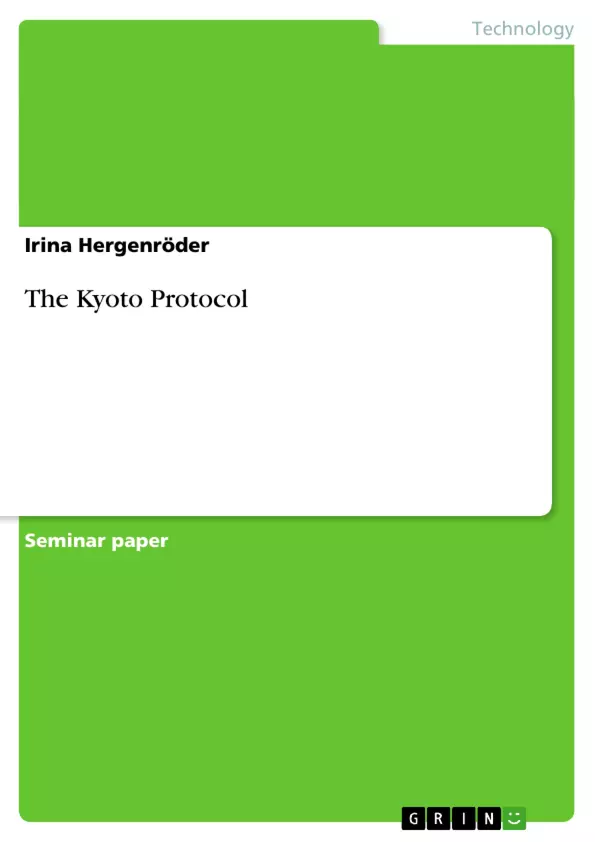The debate around the climate policy of the earth is absolutely one of most complicated and most important of our time, even if it owns no big public lobby of spectacular events. Some small island states in the South Pacific are worried by the forecast increase of the sea level above their living space. Again others see in the warming of the terrestrial atmosphere only one of the regularly returning climate variations and no reason for concern.
Hence, it is even more astonishing that one has succeeded in spite of these opinion differences in bringing this discourse in Kyoto to a result and in negotiating a protocol, which supports the process. The result of the discussion was in 1997 the Kyoto Protocol, which is to be seen till the present as a milestone in international climate policy. For a long time it was uncertain, whether it one day will come into effect - however, it has: The Kyoto Protocol obliged from the 16th February, 2005 after many years tough negotiations, more than 30 industrial states under international law to reduce their greenhouse gas emissions. Concerning this event, the following questions arise: what does the Kyoto Protocol signify? What does it contain and how effective can it really be? The present work looks at these questions.
Firstly, the natural and the anthropogenic greenhouse effect and the following predictions should be shown as bases to make clear the necessity of active climate protection policy. Afterwards the Kyoto Protocol is explained in its climate-political connections, contents and instruments and, in the end, benefits and critical points will be shown.
In my opinion, criticism is necessary to allow a comprising assessment of the protocol. Finally, it must be emphasized that with the given time a complete
representation of such a complicated subject area will not be possible. Therefore, I will explain the most important issues and give a general overview rather than go into details in order to treat the subject as the whole.
Inhaltsverzeichnis (Table of Contents)
- INTRODUCTION
- CLIMATE CHANGE AND GREENHOUSE EFFECT
- NATURAL GREENHOUSE EFFECT
- ANTHROPOGENIC GREENHOUSE EFFECT
- CONSEQUENCES AND FORECASTS
- THE KYOTO PROTOCOL
- DEFINITION OF THE KYOTO PROTOCOL
- DEFINITION OF THE CONFERENCE OF THE PARTIES
- THE ROAD TO KYOTO AND BEYOND
- CONTENT OF THE KYOTO PROTOCOL
- FLEXIBLE MECHANISMS
- Emission Bubbles
- Joint Implementation (JI)
- Clean Development Mechanism (CDM)
- International Emission Trading (IET)
- BENEFITS AND EXPECTED RESULTS OF THE KYOTO PROTOCOL
- REDUCED RATE OF GLOBAL WARMING
- BETTER CLIMATE AND ENVIRONMENTAL CONDITIONS
- BETTER HEALTH CONDITIONS
- LONG-TERM ECONOMIC BENEFITS
- FLEXIBILITY IN MEETING EMISSION TARGETS
- CRITICISM AND PROBLEMS
- EMISSION REDUCTIONS ARE NOT SUFFICIENT TO PREVENT GLOBAL WARMING
- THE PROBLEM WITH SINKS
- THE ABSENCE OF THE USA
- 2012 AND THEN?
- ANALYSIS AND OUTLOOK
Zielsetzung und Themenschwerpunkte (Objectives and Key Themes)
This work aims to provide a comprehensive understanding of the Kyoto Protocol, its implications, and its effectiveness in addressing global climate change. It explores the protocol within the context of the natural and anthropogenic greenhouse effects and investigates its benefits, criticisms, and potential for future impact.
- The natural and anthropogenic greenhouse effect and its consequences.
- The Kyoto Protocol's definition, content, and flexible mechanisms.
- Benefits and expected results of the Kyoto Protocol.
- Criticisms and challenges associated with the protocol.
- Analysis and outlook for the future of the Kyoto Protocol.
Zusammenfassung der Kapitel (Chapter Summaries)
The work begins by introducing the global climate change debate, emphasizing its complexity and importance. It then delves into the natural and anthropogenic greenhouse effects, outlining their impacts and predicting future consequences. The Kyoto Protocol is explained in detail, including its definition, content, and flexible mechanisms such as joint implementation and emission trading. The potential benefits and expected outcomes of the protocol are discussed, highlighting its role in reducing greenhouse gas emissions and promoting sustainable development. However, the work also acknowledges criticisms and challenges associated with the protocol, such as insufficient emission reductions and the absence of major players like the United States. The chapter concludes with an analysis of the protocol's current status and a forward-looking perspective on its future impact.
Schlüsselwörter (Keywords)
The key terms and concepts explored in this work include climate change, greenhouse effect, Kyoto Protocol, greenhouse gas emissions, flexible mechanisms, joint implementation, clean development mechanism, international emission trading, benefits, criticisms, and analysis.
- Quote paper
- Irina Hergenröder (Author), 2007, The Kyoto Protocol, Munich, GRIN Verlag, https://www.grin.com/document/69619



